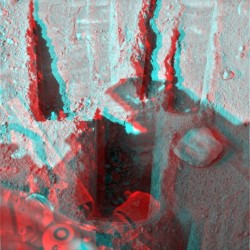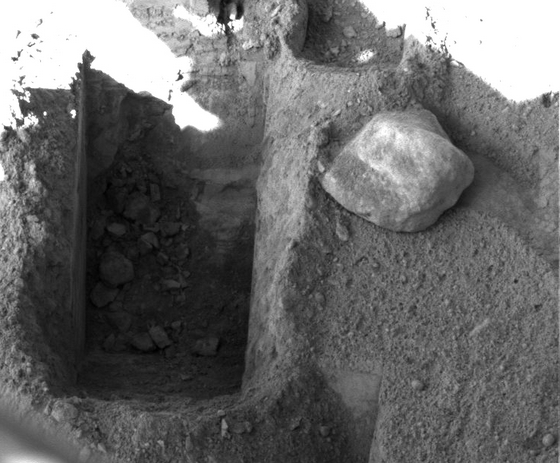The next sample of Martian soil being grabbed for analysis is coming from a trench about three times deeper than any other trench NASA's Phoenix Mars Lander has dug. On Tuesday, August 26, the scoop on the lander's robotic arm will pick up a sample of soil from the bottom of a trench called "Stone Soup" which is about 18 centimeters, or 7 inches deep. Tuesday will be the 90th Martian day or sol that the lander has been on the Red Planet, which was the original amount of time set for Phoenix's primary mission. NASA has extended the mission through September, but the clock is ticking for the plucky little lander and the oncoming winter at Mars' north polar region.
The soil sample from the deep trench will be delivered into the third cell of the wet chemistry laboratory. This deck-mounted laboratory, part of Phoenix's Microscopy, Electrochemistry and Conductivity Analyzer (MECA), has previously used two of its four soil-testing cells.
"In the first two cells we analyzed samples from the surface and the ice interface, and the results look similar. Our objective for Cell 3 is to use it as an exploratory cell to look at something that might be different," said JPL's Michael Hecht, lead scientist for MECA. "The appeal of Stone Soup is that this deep area may collect and concentrate different kinds of materials."
Stone Soup lies on the borderline, or natural trough, between two of the low, polygon-shaped hummocks that characterize the arctic plain where Phoenix landed. The trench is toward the left, or west, end of the robotic arm's work area on the north side of the lander.

When digging near a polygon center, Phoenix has hit a layer of icy soil, as hard as concrete, about 5 centimeters, or 2 inches, beneath the ground surface. In the Stone Soup trench at a polygon margin, the digging has not yet hit an icy layer like that.
"The trough between polygons is sort of a trap where things can accumulate," Hecht said. "Over a long timescale, there may even be circulation of material sinking at the margins and rising at the center."
The science team had considered two finalist sites as sources for the next sample to be delivered to the wet chemistry lab. This past weekend, Stone Soup won out. "We had a shootout between Stone Soup and white stuff in a trench called 'Upper Cupboard,'" Hecht said. "If we had been able to confirm that the white material was a salt-rich deposit, we would have analyzed that, but we were unable to confirm that with various methods."
Both candidates for the sampling location offered a chance to gain more information about salt distribution in the Phoenix work area, which could be an indicator of whether or not liquid water has been present. Salt would concentrate in places that may have been wet.
While proceeding toward delivery of a sample from Stone Soup into the wet chemistry laboratory, Phoenix is also using its Thermal and Evolved-Gas Analyzer to examine a soil sample collected last week from another trench, at a depth intermediate between the surface and the hard, icy layer.




No comments:
Post a Comment